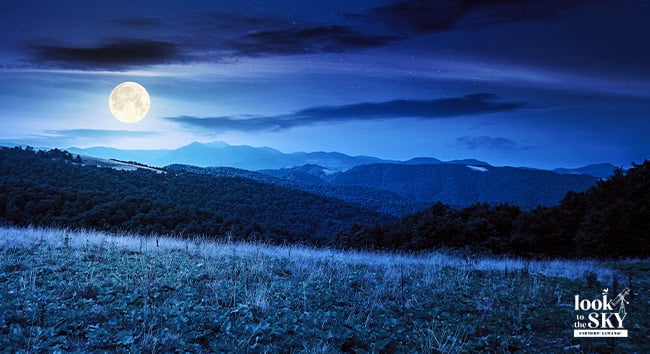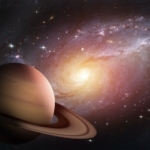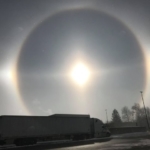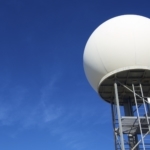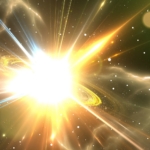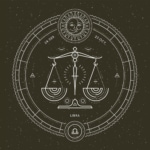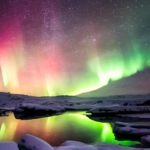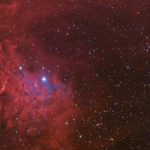The May night sky has many highlights, including a chance to see ancient dust from Halley’s Comet (as shooting stars), the Spring Triangle (a giant triangle—easy for kids to spot!), and the full Flower Moon. Early risers will get a chance to see the Moon kissing Saturn in the predawn May sky. All these sky events and more are described here in our May Night Sky Guide—your go-to source for the month’s best celestial sights! The Farmers’ Almanac expert astronomical advice has been in continuous publication since 1818.
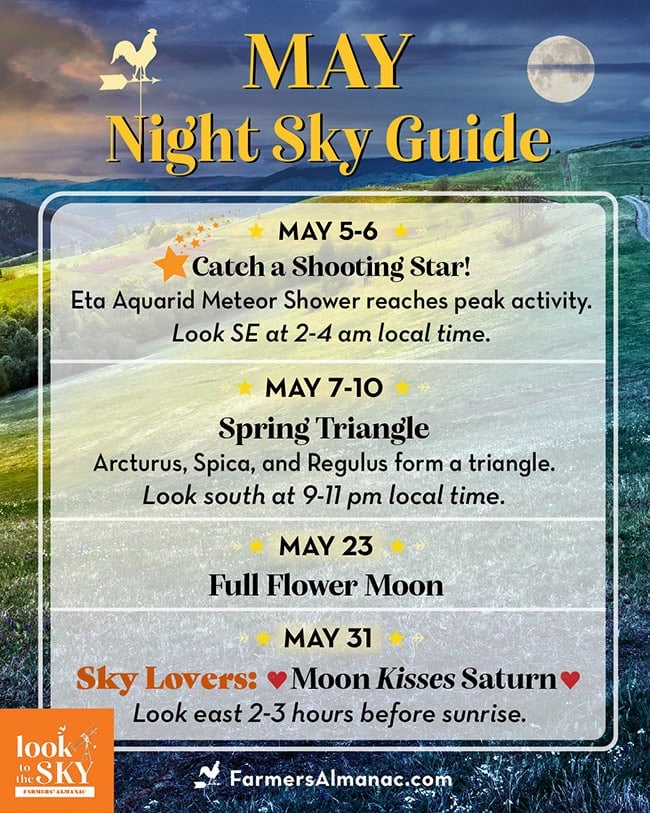
May Night Sky Guide
All times and positions are listed in Eastern time, 40 degrees north of the equator—unless otherwise specified. If you see the terms sunset, midnight, sunrise or local time, this is true no matter where you are located (no need to add or subtract for your time zone).
Any questions? Contact [email protected]
Watch out for the telescope emoji – 🔭 – which means we recommend binoculars or telescopes. Looking for a great starter telescope or more? Check out our Starry Nights Gift Guide.
May 1 – Last Quarter Moon
The last quarter Moon occurs at 7:27 a.m. EDT.
May 4+5 – “Moon Tracks” With Mars And Saturn
Up for a challenge? Look east, low on the horizon, before sunrise on May 4 and May 5 to spot a beautiful crescent Moon near Mars and Saturn. On the first morning, May 4, the Moon will be between Mars and Saturn. On the second morning, May 5, the Moon will appear to the left of Mars.
Note: Make sure that your view of the eastern horizon isn’t blocked by tall trees or buildings. Also, bear in mind that the twilight sky will be rather bright making these objects subtler than they would appear otherwise.
Mars will be a feature in the morning sky throughout the summer and most of the fall, before it moves past Earth at the start of winter 2024-2025.
Saturn’s glow is getting a little stronger (reaching magnitude +1.1) during May, and its beautiful rings will keep getting narrower for a few more months. There’s growing excitement as we get closer to seeing Saturn’s rings edge-on for the first time in 15 years (coming in March 2025).
⭐ May 5-6 – Catch A Shooting Star!
According to the 2024 Observer’s Handbook from the Royal Astronomical Society of Canada, this year’s Eta Aquarid Meteor Shower might put on an especially good show. A waning crescent Moon shedding less light than usual also helps viewing conditions.
We suggest looking southeast between 2-4 a.m. local time on May 6, 2024. If that morning doesn’t work for you, the shower will stay pretty strong—at about a quarter of its brightest—for about 10 days (May 1-10).
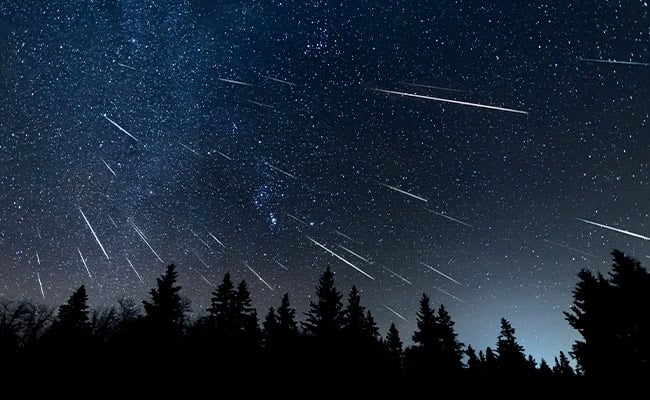
The Eta Aquarid Meteor Shower broke away from Halley’s comet 2,500 years ago, which makes it quite special and tied to the history of space.
Related product: Good Luck Bracelet
For people in the Southern Hemisphere, this is usually the best meteor shower of the year, with more than 60 meteors possible in an hour. But for those further north, the number of meteors they can see might be less impressive because the point in the sky where the meteors seem to come from isn’t very high above the southeastern horizon before dawn.
In North America, you might see about 10 meteors an hour if you’re at 26 degrees north latitude (from Miami, Florida to Oakland, California), but that number drops as you go further north. (Past 40 degrees north, you may not see many.)
⭐ May 7-10 — New Moon “Star View” – Spring Triangle
The new Moon occurs on May 7, 2024, at 11:22 p.m. EDT. If you were lucky enough to witness the total solar eclipse last month, you saw the Moon stepping in front of the Sun during its “new Moon” phase. During this event, the Moon was very close to the Earth, which is what made the eclipse “total” as opposed to a ring-shape (annual eclipse).
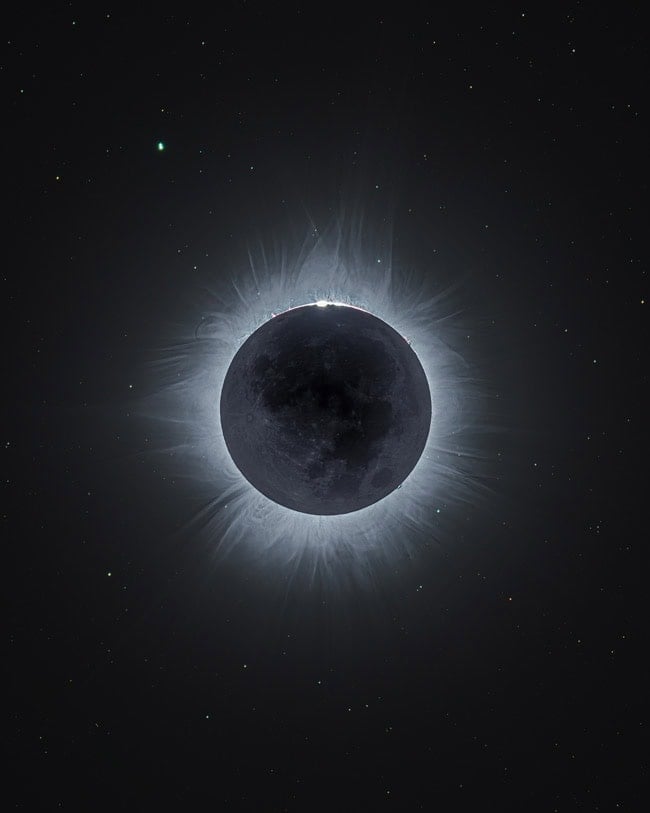
In fact April’s new Moon was considered to be a supermoon (though supermoons are usually known during full Moon phases.) May’s new Moon won’t be in perfect alignment with the Sun so it won’t create an eclipse, but it will be close enough to the Earth to be called a “supermoon.” This will be the last new supermoon of the year. (The first full supermoon of 2024 will occur in mid-August.)
New Moons are great times for stargazing because the sky tends to be a lot darker! On the evenings of May 7-10, look south between 9-11 p.m. local daylight time to gaze upon three bright stars that make up the Spring Triangle: Arcturus (in Boötes), Spica (in Virgo), and Regulus (in Leo).
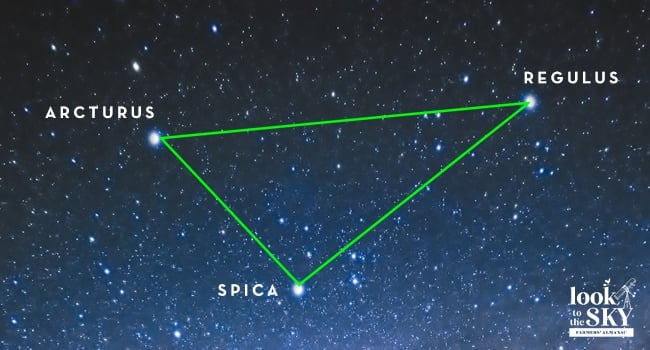
The triangle’s formation marks the arrival of spring, with its presence rising higher in the east each night. Interestingly, Arcturus, the brightest star in the triangle, held significance in Greek mythology as the “Guardian of the Bear,” watching over Ursa Major (the constellation which includes the Big Dipper) and Ursa Minor.”
Spica is known as the “ear of corn” carried by Virgo, the goddess of agriculture or harvest, which symbolizes fertility and abundance. Regulus, the brightest star in Leo, means “little king” in Latin and carries connotations of royalty, bravery, and leadership.
Note: The Spring Triangle will be visible throughout spring and into summer.
May 9 – Mercury
Mercury will be at its farthest distance from the Sun on May 9, a point called greatest western elongation. This means it will appear about 26 degrees away from the Sun in the sky. It will be brighter than usual, but only people in southern states will be able to see it without using any tools. This is because the path Mercury follows in the sky and Mercury’s position relative to it make it easier to see from places closer to the equator. In areas like Mexico City and areas further south, Mercury will be visible before the sky starts to get bright in the morning.
May 12 — Mother’s Day Moment
Does your mom love the stars? Send her a link to this sky guide and tell her how to spot the Spring Triangle! — Jump to the details. It’s super easy to spot (and great for kids too)!
Related: Mother’s Day Gift Guide 2024
May 15 – First Quarter Moon
The first quarter Moon occurs at 7:48 a.m. EDT.
May 18 – Jupiter
Jupiter is in conjunction behind the Sun and as a consequence, is not visible throughout this month. Even at month’s end it rises only about 25 minutes before the Sun.
⭐ 🔭 May 23 – Full Flower Moon
The Full Flower Moon occurs at 9:53 a.m. EDT.
Later this evening, the Moon will pass very close to the bright red star Antares in Scorpius, the Scorpion (similar to how the Moon crossed paths with Antares on March 3, 2024). This time, for places south of a line running roughly from London, Ontario, to Avalon, New Jersey, Antares will again be occulted (hidden) by the Moon.
The farther south one goes, the longer Antares will be behind the Moon. But this time, what will make it more difficult to view will be the nearly overpowering brilliance of the Moon.
Binoculars or a small telescope will be needed to see both the disappearance and reappearance of the star. From Raleigh, N.C., Antares will disappear at 9:26 p.m. EDT and will reappear at 10:11 p.m.; from Atlanta, GA, 9:17 p.m. to 10:19 p.m., and from West Palm Beach, FL, 9:13 p.m. to 10:17 p.m.
May 30 – Last Quarter Moon
The last quarter Moon occurs at 1:13 p.m. EDT.
⭐ May 31 – The Moon Kisses Saturn
This will be a much closer approach compared to May 4 and 5. This time, the Moon will slip just about one degree below Saturn (about the size of your pinky fingertip). Saturn will appear as a bright, non-twinkling star shining with a yellow color.
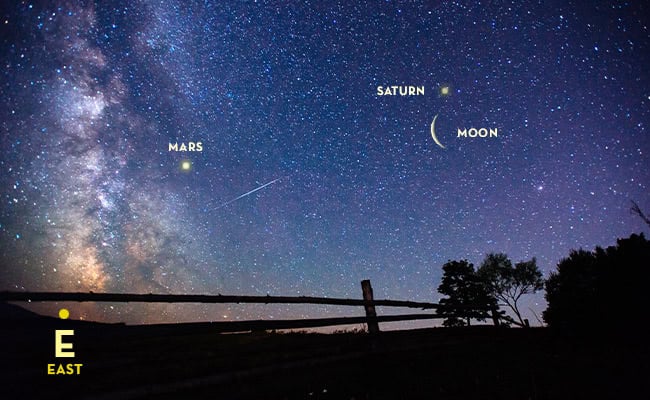
Saturn (magnitude of +1.1) sits about two degrees above the Moon, while Mars (approximately the same brightness, magnitude +1.2), will be to the upper right.
Any questions? Contact [email protected]
Join The Discussion
Which sky event are you looking forward to in the May night sky?
Do you have any questions or suggestions for our sky guide?
Share with your community here in the comments below!

Joe Rao
Joe Rao is an esteemed astronomer who writes for Space.com, Sky & Telescope, and Natural History Magazine. Mr. Rao is a regular contributor to the Farmers' Almanacand serves as an associate lecturer for the Hayden Planetarium in New York City.

